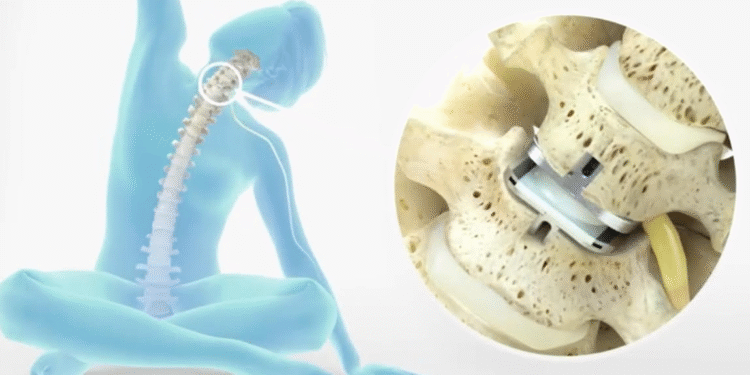Artificial disc replacement has transformed spinal care by offering a motion-preserving alternative to spinal fusion. Among the many factors that influence surgical outcomes, the materials used in disc implants play a critical role. Titanium and polymer-based artificial discs are two widely used options, each with distinct strengths and limitations. Dr. Larry Davidson, a leader in spinal surgery, highlights the importance of understanding how material choice impacts flexibility, comfort and long-term function. As patients and clinicians navigate these options, a clear comparison can help guide more personalized and effective treatment decisions.
As spinal implant technologies continue to advance, the debate over which materials provide the best balance of flexibility and durability remains central. Both titanium and polymer-based discs are designed to restore mobility and reduce pain, but they achieve these goals in different ways. Understanding how each material interacts with the spine under real-world conditions helps clarify their respective roles in modern disc replacement surgery.
The Role of Material in Artificial Disc Design
Artificial discs are designed to mimic the natural disc’s function, preserving spinal mobility and absorbing loads across vertebral segments. Material selection plays a crucial role in the implant’s ability to replicate these functions. Titanium, known for its strength and biocompatibility, has long been a staple in orthopedic implants. Conversely, polymer-based materials, particularly medical-grade polyethylene and polyurethane, offer elasticity and shock absorption that more closely resemble the mechanical behavior of natural discs.
The material choice affects not only the disc’s performance but also the patient’s postoperative experience, including range of motion, pain relief and long-term spinal health. Thus, evaluating how each material performs under the physiological demands of daily life is essential.
Titanium-Based Artificial Discs: Strength and Stability
Titanium-based discs are often chosen for their superior strength and resistance to mechanical wear. These implants provide a high degree of stability and are less prone to deformation under load. Their durability makes them especially suitable for patients with heavier body weights or more advanced spinal degeneration.
Another key benefit of titanium is its biocompatibility. Titanium naturally integrates with surrounding bone through a process called osseointegration, promoting implant stability over time. This property reduces the risk of implant migration and contributes to long-term success.
However, titanium’s rigidity can be a double-edged sword. While strong and durable, it lacks the elasticity needed to fully mimic the natural disc’s flexibility. This can result in a less natural range of motion, potentially placing stress on adjacent spinal segments.
Polymer-Based Artificial Discs: Flexibility and Biomechanical Mimicry
Polymer-based discs are engineered to offer more natural flexibility and motion. These materials are capable of absorbing and distributing loads in a way that closely mirrors the behavior of a healthy spinal disc. Patients receiving polymer-based implants often report improved comfort and smoother motion, especially in activities involving bending or rotation.
Medical-grade polymers like polyethylene are also known for their low wear rates, making them suitable for long-term implantation. Some polymer discs are designed with viscoelastic properties, enabling dynamic motion across multiple planes, something that rigid titanium structures struggle to replicate.
One potential drawback is the risk of material fatigue over time. While modern polymers are highly durable, they may still be more susceptible to deformation under repetitive stress compared to metals. Additionally, polymer implants typically require more precise surgical placement to ensure long-term performance and stability.
Flexibility Comparison: Which Material Performs Better?
When it comes to flexibility, polymer-based discs tend to outperform titanium alternatives. Their ability to deform slightly under pressure and rebound to their original shape makes them well-suited for preserving motion in the spine. Clinical studies have shown that polymer-based implants provide a more natural range of motion, which may reduce the incidence of adjacent segment degeneration.
Titanium discs, while effective in maintaining disc height and stability, generally offer a more constrained range of motion. This can limit spinal flexibility and may impact the patient’s ability to perform certain movements comfortably. However, newer hybrid designs that incorporate both titanium frameworks and polymer cores aim to bridge this gap by offering the best of both worlds.
Durability and Longevity of Each Material
Durability is another crucial factor when comparing these two materials. Titanium’s resistance to corrosion and mechanical failure makes it an excellent choice for long-term use. These discs often last decades without significant degradation, which is a major advantage for younger patients or those with active lifestyles.
While offering greater flexibility, polymer-based discs may require more frequent monitoring due to the potential for wear and tear. Nevertheless, advances in material science have led to significant improvements in the longevity of these implants. High-performance polymers are now engineered to resist fatigue and wear, bringing their lifespan closer to that of their metal counterparts.
Biocompatibility and Imaging Considerations
Both titanium and polymer materials are generally well-tolerated by the body, but they differ in how they interact with diagnostic imaging. Titanium can sometimes cause artifacts in MRI scans, making it more challenging to assess soft tissue conditions postoperatively. Polymer-based discs typically produce fewer imaging distortions, allowing for clearer diagnostic evaluations.
Both materials have proven track records in biocompatibility. However, individual responses can vary based on factors like surgical technique, patient health and implant positioning. Proper surgical planning and follow-up care are essential regardless of the material used.
Patient-Specific Considerations in Material Selection
Choosing between titanium and polymer-based discs depends on multiple patient-specific factors. Patients who prioritize long-term durability and are less concerned with maximum flexibility may prefer titanium implants. Those seeking to maintain a more natural spinal range of motion, especially younger or more active individuals, might find polymer-based discs more appealing.
Dr. Larry Davidson emphasizes, “If the progress that has been made in this field, just in the last decade, is any indication of the future, then I would predict a continuation of significant advances not only in surgical approaches but also the technology that helps the spine surgeon accomplish his/her goals.” This forward-looking perspective highlights how ongoing innovation in disc materials and surgical techniques will continue to improve outcomes and expand options for a wider range of patients.
Other considerations include bone quality, the extent of disc degeneration, comorbidities and previous spinal surgeries. A thorough preoperative evaluation, including imaging, physical assessments and lifestyle discussions, helps determine the most appropriate material for each case.
Striking the Balance Between Strength and Flexibility
Titanium and polymer-based artificial discs each offer meaningful advantages in spinal disc replacement. Titanium is valued for its strength, resistance to wear and long-term structural support. Polymer-based materials, meanwhile, provide more natural flexibility and better mimic the spine’s dynamic motion. Rather than identifying one material as universally superior, the best outcomes often come from tailoring the implant choice to the patient’s unique anatomy, lifestyle and surgical goals.
With continued innovation in biomaterials and implant design, the future of spinal disc replacement lies in balancing strength with flexibility. Whether through refined polymers, titanium-polymer hybrids or next-generation smart implants, material selection will remain a critical factor in optimizing both motion preservation and long-term spinal health.
































